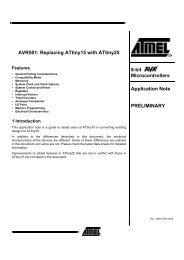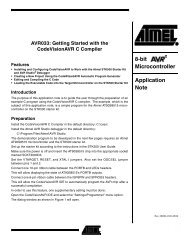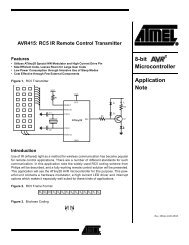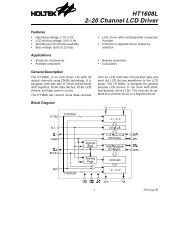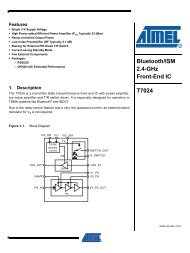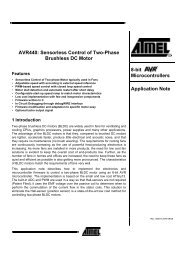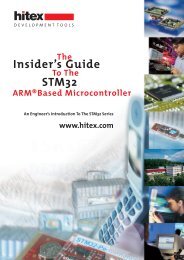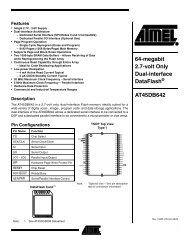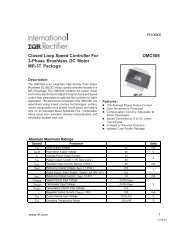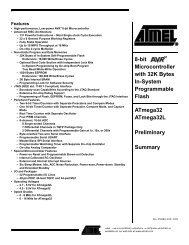Preliminary C8051F120/1/2/3 C8051F124/5/6/7 - KEMT FEI TUKE
Preliminary C8051F120/1/2/3 C8051F124/5/6/7 - KEMT FEI TUKE
Preliminary C8051F120/1/2/3 C8051F124/5/6/7 - KEMT FEI TUKE
Create successful ePaper yourself
Turn your PDF publications into a flip-book with our unique Google optimized e-Paper software.
<strong>C8051F120</strong>/1/2/3<br />
<strong>C8051F124</strong>/5/6/7<br />
<strong>Preliminary</strong><br />
14.4. External Crystal Example<br />
If a crystal or ceramic resonator is used as an external oscillator source for the MCU, the circuit should be configured<br />
as shown in Figure 14.1, Option 1. The External Oscillator Frequency Control value (XFCN) should be chosen from<br />
the Crystal column of the table in Figure 14.5 (OSCXCN register). For example, an 11.0592 MHz crystal requires an<br />
XFCN setting of 111b.<br />
When the crystal oscillator is enabled, the oscillator amplitude detection circuit requires a settle time to achieve<br />
proper bias. Waiting at least 1 ms between enabling the oscillator and checking the XTLVLD bit will prevent a premature<br />
switch to the external oscillator as the system clock. Switching to the external oscillator before the crystal<br />
oscillator has stabilized can result in unpredictable behavior. The recommended procedure is:<br />
Step 1. Enable the external oscillator.<br />
Step 2. Wait at least 1 ms.<br />
Step 3. Poll for XTLVLD => ‘1’.<br />
Step 4. Switch the system clock to the external oscillator.<br />
Important Note on External Crystals: Crystal oscillator circuits are quite sensitive to PCB layout. The crystal<br />
should be placed as close as possible to the XTAL pins on the device. The traces should be as short as possible and<br />
shielded with ground plane from any other traces which could introduce noise or interference.<br />
14.5. External RC Example<br />
If an RC network is used as an external oscillator source for the MCU, the circuit should be configured as shown in<br />
Figure 14.1, Option 2. The capacitor should be no greater than 100 pF; however for very small capacitors, the total<br />
capacitance may be dominated by parasitic capacitance in the PCB layout. To determine the required External Oscillator<br />
Frequency Control value (XFCN) in the OSCXCN Register, first select the RC network value to produce the<br />
desired frequency of oscillation. If the frequency desired is 100 kHz, let R = 246 kΩ andC=50pF:<br />
f=1.23(10 3 )/RC=1.23(10 3 ) / [ 246 * 50 ] = 0.1 MHz = 100 kHz<br />
Referring to the table in Figure 14.5, the required XFCN setting is 010.<br />
14.6. External Capacitor Example<br />
If a capacitor is used as an external oscillator for the MCU, the circuit should be configured as shown in Figure 14.1,<br />
Option 3. The capacitor should be no greater than 100 pF; however for very small capacitors, the total capacitance<br />
may be dominated by parasitic capacitance in the PCB layout. To determine the required External Oscillator Frequency<br />
Control value (XFCN) in the OSCXCN Register, select the capacitor to be used and find the frequency of<br />
oscillation from the equations below. Assume VDD = 3.0 V and C = 50 pF:<br />
f = KF / ( C * VDD ) = KF / ( 50 * 3 )<br />
f = KF / 150<br />
If a frequency of roughly 50 kHz is desired, select the K Factor from the table in Figure 14.5 as KF = 7.7:<br />
f = 7.7 / 150 = 0.051 MHz, or 51 kHz<br />
Therefore, the XFCN value to use in this example is 010.<br />
Page 166<br />
DS008-0.8-AUG02 © 2002 Cygnal Integrated Products, Inc.



